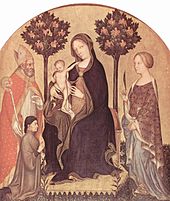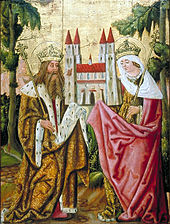Founder picture


The figurative representation of a donor or client of a work of fine art, which shows one or more donors , documents their authorship and calls on the viewer to pray for his or her salvation, is referred to as a donor image or figure .
history
Representations of donors can already be found in the corners of a few Roman mosaics . Occasionally they also appear in early Christian art . In the Middle Ages, they are more frequently and adhere to the Baroque period . In early works of art, the donors, sometimes together with relatives, are shown clearly reduced in size at the edge of the scene (see perspective of meaning ). Later, donor figures are also integrated into the scenery by individual patron saints and are increasingly portrayed realistically.
object
The object of a foundation can be a codex , a building, a glass window, a sculpture or an altarpiece that the donor has financed to produce. The person who commissioned a manuscript is often shown when the donated work is handed over to a church, represented by a personification of the saint, in this case a dedication image takes on the function of the donor's portrait. Founders of buildings are usually shown with an architectural model that the founder bears as an attribute.
function
Apart from the general invitation to prayer, a donor's picture also has the function of documenting a legal act. Either it was law or it was reminiscent of a legal act. A religious foundation served the purpose of taking out insurance for the afterlife. Here piety has become, as it were, 'arithmetic'. The good works were added up - u. a. with this foundation - so as not to be found too easy at the Last Judgment .
Representations of donors in early Dutch painting of the 15th century probably served as reflective figures on which those praying could reflect and meditate on their own prayer and their sinful status. This self-reflection is required in late medieval prayer tracts and especially in the writings of the Devotio moderna . It should lead those who pray to a self-knowledge and above that to a knowledge of God. In the case of media of personal piety such as diptychs , the impetus for this process of self-reflection and self-knowledge must have been all the stronger because there the founder prayed in front of his own , praying image.
literature
- Klaus Gereon Beuckers : The Ottonian donor image . Image types, motives for action and donor status in Ottonian and Early Sali donor representations. In: Klaus Gereon Beuckers, Johannes Cramer, Michael Imhof (eds.): Die Ottonen. Art - architecture - history . 2nd Edition. Imhof, Petersberg 2006, ISBN 978-3-932526-91-6 , p. 63-102 (first edition: 2002).
- Gerhard Straehle: The Naumburg Stifter Cycle and the Slain in the West Choir (Synodal Choir) of Naumburg Cathedral. Langewiesche publishing house , Königstein 2012, ISBN 978-3-7845-2960-8 .
- Johanna Scheel: The old Dutch image of the founder. Emotional strategies of vision and self-awareness. Gebr. Mann, Berlin 2013, ISBN 978-3-7861-2695-9 .
Web links
Individual evidence
- ^ Johanna Scheel: The old Dutch donor picture. Emotional strategies of vision and self-awareness. Gebr. Mann, Berlin 2013, ISBN 978-3-7861-2695-9 .

